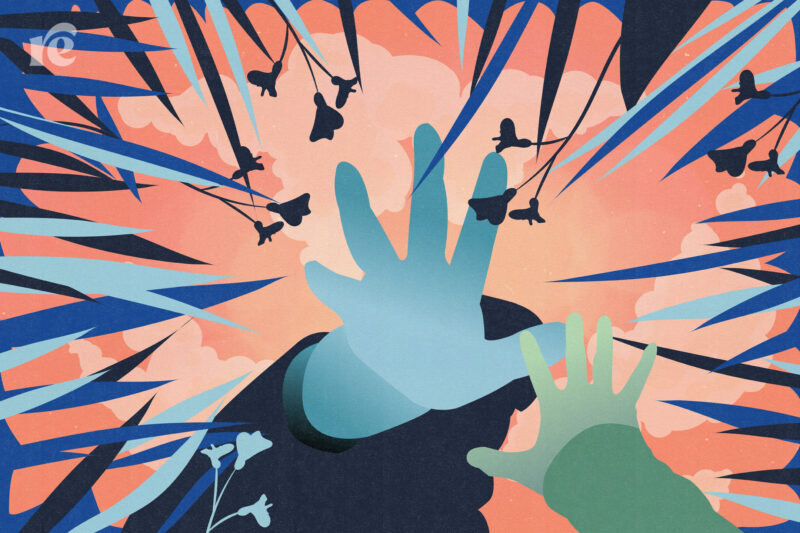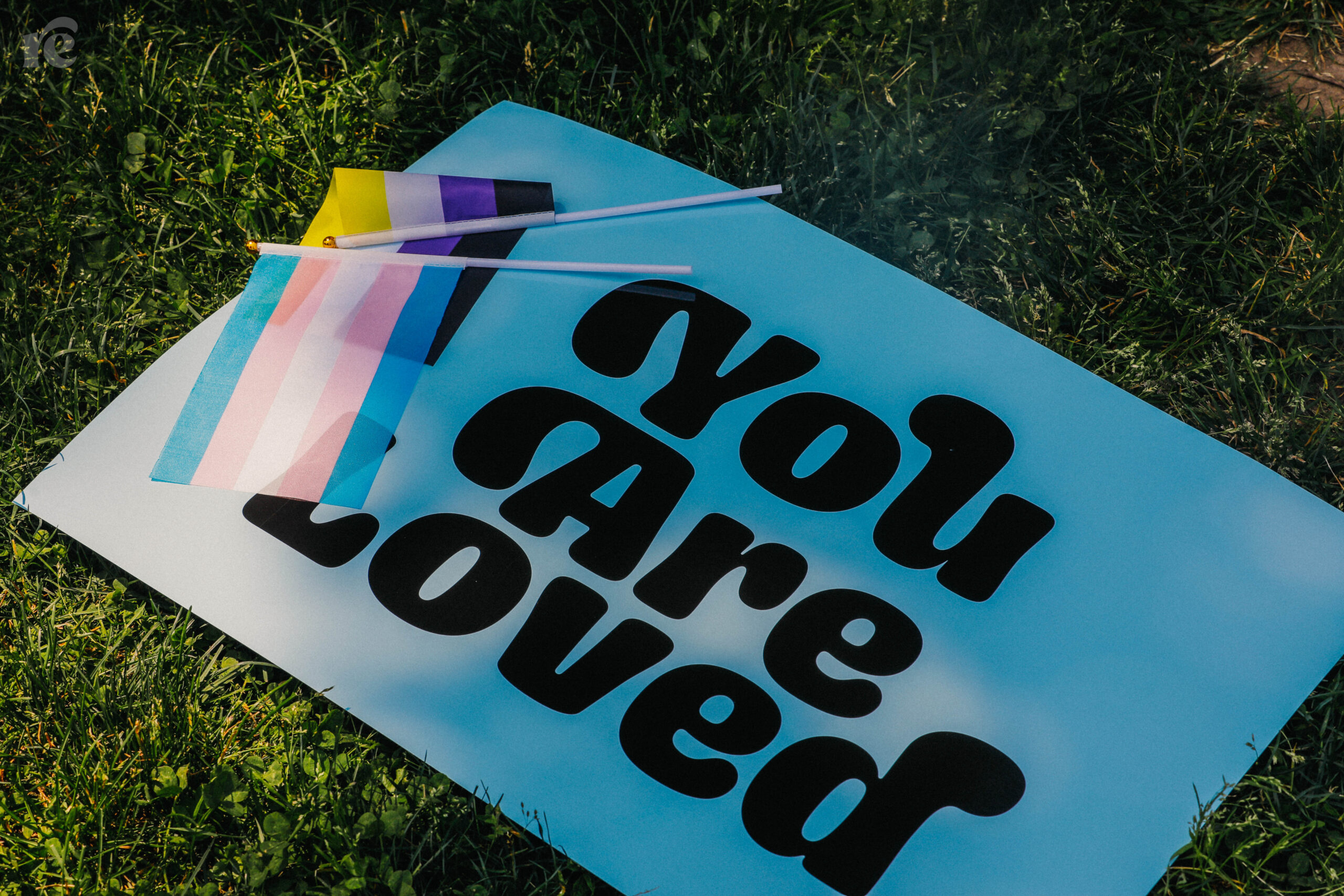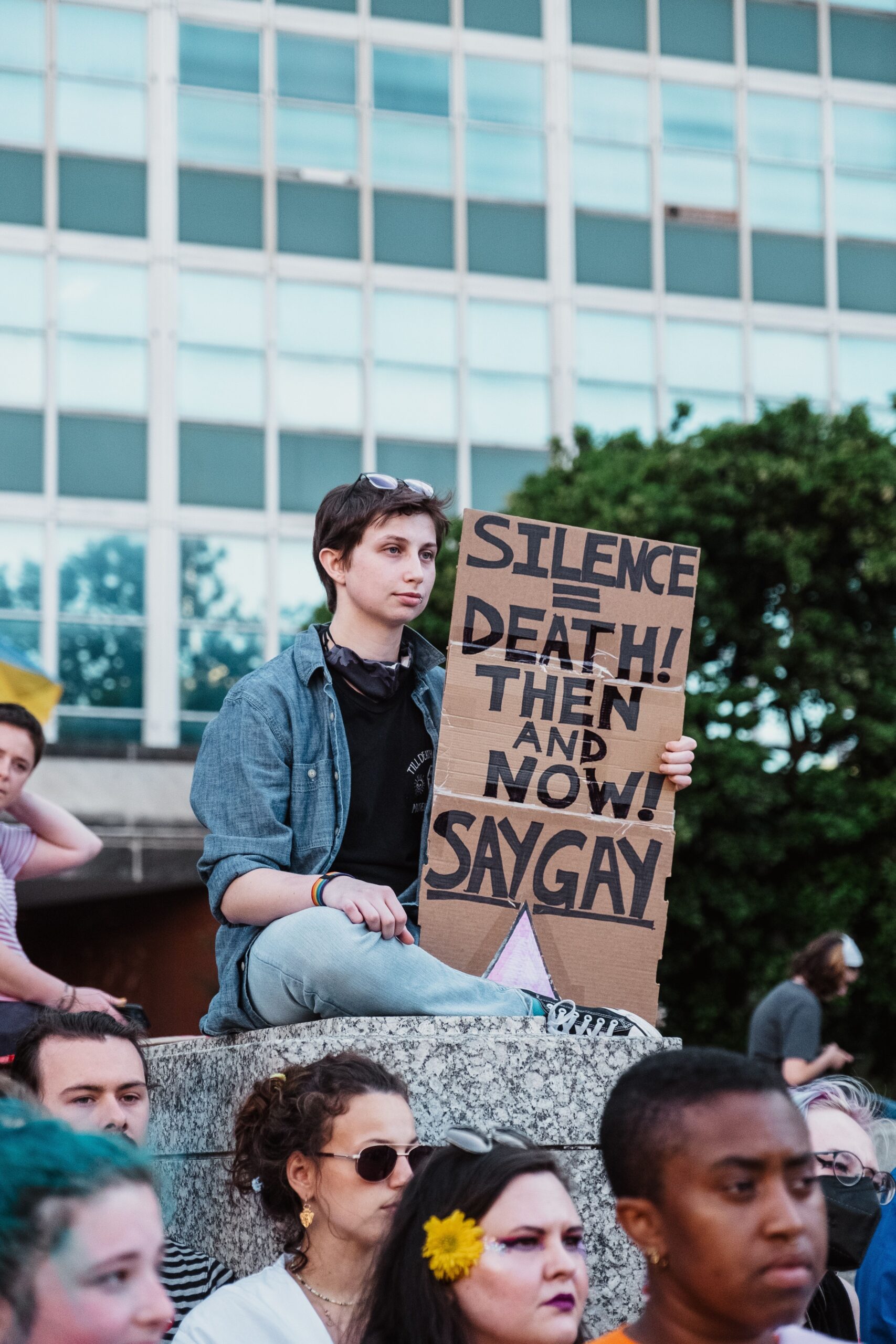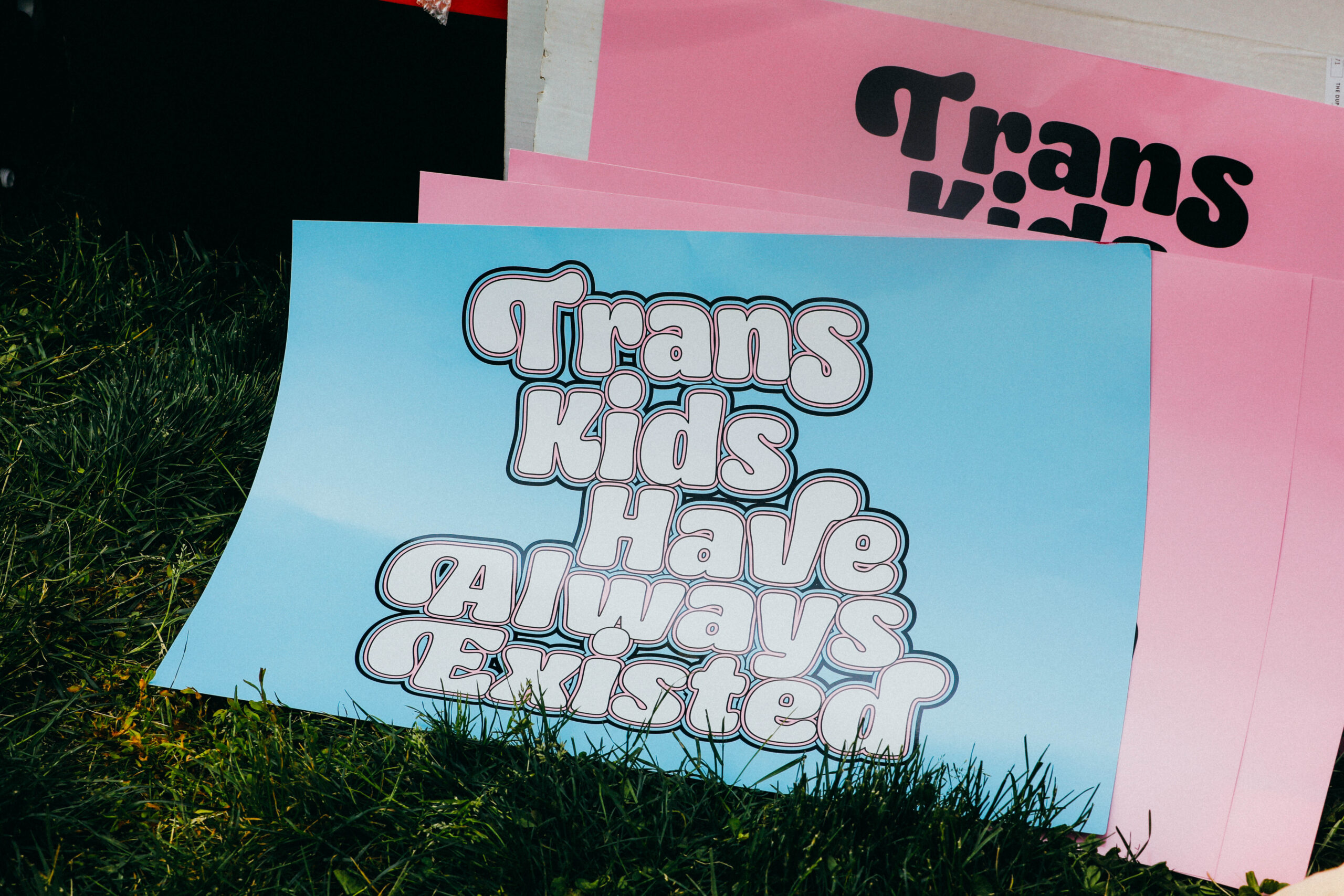Meet the Children of LGBTQ+ Parents Who Are Reclaiming the Narrative
The children of LGBTQ+ people are ostensibly at the center of a conservative agenda. In actuality, "we are often erased in these conversations."

This is part one in a two-part series. Check out part two here.
Since January, state legislatures have proposed more than 500 pieces of anti-LGBTQ+ legislation. These bills primarily seek to criminalize transgender children, parents, and their families.
Fascist groups and conservative lawmakers have simultaneously ramped up propaganda falsely alleging that LGBTQ+ people are more likely to harm children—a pernicious myth that has caused decades of harm to trans and queer communities. In reality, people raised by queer and trans caretakers have similar well-being to those who haven’t.
The children of LGBTQ+ people, alongside queer and trans kids, are ostensibly at the center of this legislative agenda. In actuality, “we are often erased in these conversations,” said Jordan Budd, executive director of COLAGE, the largest U.S. organization for the children of LGBTQ+ people and the first Black, queer person in the role. He has a bisexual birth father.
“Gay parents exist, and their kids are old enough to speak for themselves,” Budd said.
I talked to a handful of adult children and grandchildren of queer and trans people—many of whom are LGBTQ+ themselves—to hear their experiences of family, discrimination, and care. They come from a range of family and cultural backgrounds, and most grew up in the Midwest and South. And they all have connections to COLAGE, meaning they represent a politically active group with the resources to access a national nonprofit.
I first spoke to them in May 2022; I checked back early this year. I also talked to scholars and legal experts, who helped contextualize how state violence, family law, and institutional racism shape LGBTQ+ families’ lives.
I’m a queer, cisgender white woman in my early 30s, raised by straight parents, dreaming—with equal parts trepidation and hope—about what family could look like for me and for queer communities across the United States.
Many of the people I talked to expressed a sense of whiplash. On one hand, increasing social acceptance in the United States has led to more queer and trans people coming out: As of 2022, 7 percent of Americans identified as LGBTQ+. This contrasts with a surge in anti-LGBTQ+ legislation, propaganda, and violence—which many call a conservative backlash to advances in queer and trans rights as well as racial justice.
The LGBTQ-parented people I spoke to shared a vision of the queer movement that centers trans people and people of color.
“A lot of the faces of marriage equality and family acceptance have been white, cis queer folks,” said Adrian Ogle, a queer child of a queer mom and a COLAGE board chair emeritus who works in philanthropy. “We want to continue to break that paradigm. We are made of a multiplicity of families and backgrounds and experiences.”
Current anti-LGBTQ+ legislation is part of a long history of the U.S. government policing marginalized, particularly Black and Indigenous, families. In contrast, the multilayered experiences of the children of LGBTQ+ people—and their refusal to flatten their humanity to fit heteronormative constructs—challenge society at large to imagine more expansive and inclusive forms of family, community, and care.
Part one of this two-part series looks at who LGBTQ+ families are, and how histories of institutional racism shape today’s anti-trans and queer legislation. Part two will examine how discrimination shapes queer and trans families’ daily lives, and how the children of LGBTQ+ people support one another as they advocate for a more liberated world.
Who are LGBTQ+ families?
Research institutions have historically marginalized accurate information on gender and sexuality—and recent state legislation censoring the study of gender and race exacerbates this. So it’s hard to know exactly how many people in the United States are parented by LGBTQ+ people.
As of 2015, researchers estimated that up to 3.7 million U.S. children under age 18 have at least one LGBTQ+ parent. Fifteen percent of people in same-sex couples in the country are raising a child. And the community of queer- and trans-parent families is likely to grow, as LGBTQ+ people are coming out more often and earlier, and many are planning to have children.
LGBTQ-parented people of all genders and sexualities may describe themselves as culturally queer, as having a queer family structure, or as queerspawn. The tongue-in-cheek term reclaims the disgust society often directs against trans and queer families—much as LGBTQ+ activists reclaimed the once-slur “queer.”

The adult children of queer and trans caretakers are more likely to be LGBTQ+ themselves. This is likely because their parents create a more affirming environment in which children can embrace their identities, University of Amsterdam Professor Henny Bos said. She’s a co-investigator of the National Lesbian Longitudinal Family Study, which has followed a U.S. group of people with lesbian parents since the 1980s.
Dominant media accounts and even LGBTQ+ nonprofits typically depict queer people parenting within monogamous, same-sex, largely white couples. In reality, queer families are as diverse as queer people. For example, only 3 percent of bisexual parents are in same-gender couples (a third are in different-gender relationships, and most are single). LGBTQ+ people parent solo, in same- or different-gender couples, as part of non-monogamous relationships, or as caretakers to young people in their communities, whether or not they are biologically or legally related.
One of my interviewees was adopted by an out gay couple; one was raised by his mother and learned his birth father was queer later in life. The others had parents in seemingly heterosexual couples, who broke up after one partner came out as queer or transgender.
Rates of parenting differ based on sexual orientation and gender identity. Queer women are more than twice as likely to be parents than queer men (studies often don’t distinguish between cis and trans men and women). The scant available data tell us that about 19 percent of transgender adults are parents, and the majority of trans people want children in the future.
Black, Indigenous, and Latinx queer people are more likely to care for children than queer people of other races and ethnicities. In one study of people in same-sex relationships, 41 percent of women of color and 20% of men of color cared for children under 18—around twice as many as their white counterparts. LGBTQ+ people of color living in the Midwest, Mountain West, and South form the largest group of LGBTQ+ families.
Cultural conceptions of kinship shape LGBTQ+ families. For example, people of color in the United States are more likely than white people to live in multigenerational households. In Black communities, “Someone’s your auntie, someone’s your uncle, someone’s your cousin, whether biological or not,” Ogle said. Further, in many Native American communities, Two Spirit people play integral roles in caring for youth.
This historical and contemporary diversity shows us that far from being the norm, the heterosexual, two-parent nuclear family, in which neither parent has been divorced, is actually a minority family structure.
But it’s a family structure that state institutions have, historically and today, enforced.
Policing families
When legal scholar and American University professor of law emerita Nancy Polikoff first started practicing LGBTQ+ family law in the 1970s, child custody was “the most critical issue facing lesbians” in the legal field, she said.
Many lesbians married and had children with men, then came out and got divorced. Ex-husbands, relatives, and state agencies often attempted to terminate mothers’ parental rights on the basis of homophobic beliefs. One person I spoke to, now in their late 20s, said that, during their parents’ divorce proceedings when they were a child, lawyers argued their mother was an “unfit” parent because she was queer.

Both the threat and reality of forced separation are profoundly traumatic for children.
Lawyers of Polikoff’s generation used inventive legal strategies to build case law affirming LGBTQ+ parental rights.
“Because we had nothing to depend on, we made it all up,” said Michele Zavos, co-founder of Rainbow Families (one of the first U.S. groups for lesbians considering parenthood), who started practicing LGBTQ+ family law in the 1980s.
Lawyers helped win legal protections that thousands of LGBTQ+ families benefit from today: second-parent adoption, non-discrimination laws, and marriage rights.
Yet the threat to LGBTQ+ families never went away. It is intertwined with systemic racism. State agencies are far more likely to remove Black and Indigenous children from their families than white children. And research shows that government agencies are four times more likely to remove lesbian and bisexual Black women’s children from their families and into state custody as those of heterosexual Black women.
Meanwhile, recent legislation uses the language and infrastructure of child welfare to surveil and police transgender children and parents. For example, Florida’s SB 254, proposed in early March, would give courts the power to take children from their parents if the state believes the child may receive gender-affirming medical care. An earlier draft of the bill, which has since been edited, seemed to open a legal pathway for the state to remove children from transgender parents, as well. In truth, gender-affirming care is lifesaving, and greatly enhances the well-being of both trans children and trans parents.
According to state agencies, forced separations are in response to allegations of parental abuse and neglect. But researchers and the lived experience of affected families tell us that state agencies regulating parenting overwhelmingly target and police poor families of color who do not conform to white, middle-class, cisgender, and heterosexual family structures.
“The child welfare system has historically and today punished families who don’t meet that norm”—particularly Black and Indigenous families, said Dorothy Roberts, a professor of Africana Studies, law, and sociology at the University of Pennsylvania. Roberts has published extensively on family policing, and is a leading academic voice in the movement for family policing abolition.
Case records offer evidence of widespread discrimination against LGBTQ—and particularly transgender—parents, especially parents of color and those living in poverty. In records from a 2017 Kansas custody case Polikoff analyzed, a case worker told a lesbian mother she needed to be “fixed” and “go back to loving a man”; a judge terminated her parental rights two years later. In another Kansas case, in which the state removed a transgender child from the child’s lesbian parents, a social worker repeatedly said “we’re not giving this child back to lesbians;” the judge placed the child in foster care.
Lawmakers laid the foundations of family policing after Reconstruction, when courts removed Black children from their parents and forced them to work as “apprentices” for white plantation owners—reenslaving them, Roberts said. The government weaponized child removal in the genocide of Native Americans, forcing Indigenous children into abusive residential schools.
By claiming “child welfare” to police transgender children and caretakers, state legislators invoke a larger infrastructure—including criminal, family, and immigration courts—that disproportionately criminalizes impoverished Black, Indigenous, and other communities of color. And they further state-sanctioned medical gatekeeping and coercion, which are rooted in systemic racism and particularly harm people with disabilities and trans people.
U.S. courts are far more likely to incarcerate queer people, especially transgender people, than their heterosexual, cisgender peers of the same racial and economic groups. One study found that 44 percent of incarcerated LGBTQ+ people are parents; social scientists have devoted little research to how many of their children end up in foster care.
The threat and act of child removal are ways “to terrorize politically marginalized communities,” Roberts said. In light of this, “It’s so important that people see these recent attacks on trans families as part of a broader spectrum of harms to families caused by this system, and then that we join together and not see these as separate movements,” she said.
Reclaiming the narrative
Many people I interviewed—especially those with transgender parents, and queer parents of color—said they experienced profound pressure to represent their parents according to cisgender, heterosexual family norms.
“It’s like, ‘Oh, if you don’t have a perfect family, you’re definitely not fit to be a parent,’’ said Olivia Bartholomaei, a nonprofit worker and COLAGE volunteer with a transgender parent. In reality, Bartholomaei said, people with trans parents have unique, individual relationships with those parents—like everyone does. There are no significant differences in well-being and happiness between trans and cis parent-child relationships, except for the effects of systemic transphobia.

The pressure to represent one’s parent creates a “tremendous psychological burden” for trans and queer people’s kids, said Kenji Kuramitsu—an observation social science research affirms. Kuramitsu is a queer, Chicago-based therapist and COLAGE board member with a lesbian parent.
This pressure also shapes the narratives that researchers and journalists tell about LGBTQ+ families. I asked Bos, the lesbian families researcher, how propaganda against LGBTQ+ parents affects how she presents her results. When discussing her data on the sexual orientations of the lesbian-parented people in her study, “I’m always starting—and I don’t know why—I’m always starting with saying that the majority is heterosexual. It looks like I’m internalizing something myself.”
Queer and trans identities are normal human expressions, part of the vast historical and global diversity of gender and sexuality. Data indicating that the adult children of LGBTQ+ parents are more likely to be LGBTQ+ themselves points to an affirming environment for children’s identity development. But propaganda like the false and harmful “groomer” slur can make representation high stakes for community members, researchers, and journalists, including me.
My interviewees expressed a craving for authentic stories that give space for LGBTQ+ families’ complex, sometimes messy, always valuable, human lives. Bartholomaei found these stories in community spaces for folks with trans parents.
“It’s been really reaffirming to be like, no one’s perfect,” including cis and hetero families, she said. “Any queer person is an individual as well. There’s no mold to be a human.”
Kuramitsu credits spaces like COLAGE with helping him celebrate trans and queer families in all their complex authenticity. This experience of community—beyond “the neat, Supreme Court brief sign-on, media clip story”—sustains him.
“That has allowed me to continue doing work in the world: knowing there’s a community of folks who fly faster than I can fall if I need support—and to whom I can also extend solidarity and care,” Kuramitsu said.
Ray Hobbs contributed editorial feedback as a sensitivity reader.
